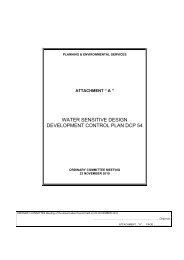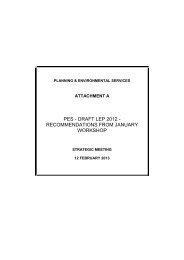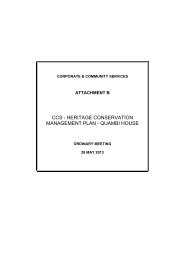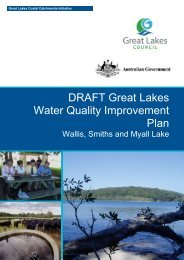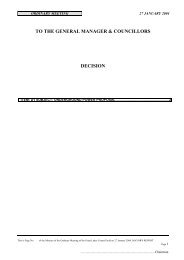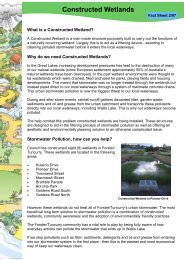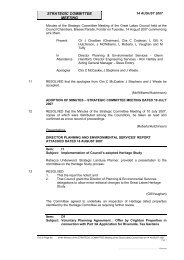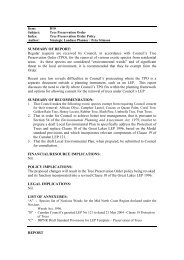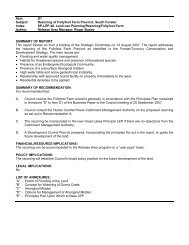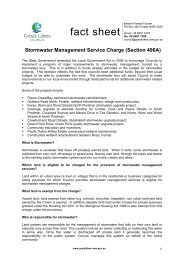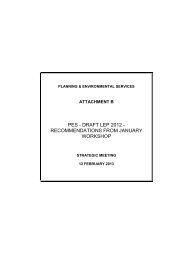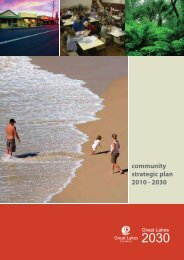smiths lake planning study volume 1: text - Great Lakes Council
smiths lake planning study volume 1: text - Great Lakes Council
smiths lake planning study volume 1: text - Great Lakes Council
Create successful ePaper yourself
Turn your PDF publications into a flip-book with our unique Google optimized e-Paper software.
STORMWATER MANAGEMENT 34<br />
4 STORMWATER MANAGEMENT<br />
4.1 Introduction<br />
This section of the report assesses stormwater management requirements for both the SLA and<br />
SLVA. The approach taken in regard to this issue, and the findings of our assessments are<br />
closely related to the Water Quality Sensitivity Mapping activities discussed in Section 7.<br />
In accordance with acceptable and contemporary stormwater management <strong>planning</strong> practice,<br />
this <strong>study</strong> has not just considered stormwater from a drainage perspective. An holistic<br />
viewpoint has been taken, making appropriate stormwater management recommendations<br />
based on the consideration of a wide range of issues, including the following:<br />
• receiving water environmental and ambient quality characteristics;<br />
• catchment characteristics such as slope, soil type and vegetation cover; and<br />
• development characteristics, such as urban density and how stormwater infrastructure can<br />
be integrated within urban area layouts.<br />
In this regard, firstly the receiving environment characteristics of the <strong>study</strong> catchments are<br />
described, and whole of catchment stormwater/pollutant export objectives are specified.<br />
Subsequently, relevant stormwater management actions that are recommended to apply across<br />
the entire catchment are introduced, and finally additional actions required in areas of specific<br />
stormwater related ‘sensitivity’ are discussed.<br />
4.2 Receiving Environment Implications<br />
Section 7.2 of this report presents a summary of available water quality data for both Wallis<br />
and Smiths <strong>Lakes</strong>. Other discussion contained in Section 7 introduces the recommendations of<br />
this <strong>study</strong> that there be a ‘no worsening’ criteria applied with respect to non-point source<br />
(stormwater) pollutant export. This recommendation is a key influence on the acceptable<br />
nature of development and stormwater infrastructure within the SLA and SLVA.<br />
4.3 Whole of Study Area Considerations<br />
As described above, both Smiths and Wallis <strong>Lakes</strong> are sensitive to significant changes in<br />
catchment/stormwater pollutant export. The basic reasons for this are:<br />
• Smiths Lake is in an almost ‘natural’ condition and has little capacity for assimilating<br />
change in catchment loads due to the long retention times of the <strong>lake</strong> and occasional vertical<br />
water column stratification; and<br />
• Wallis Lake nutrient levels are already higher than desirable due to other catchment inputs<br />
and the poor flushing characteristics of the southern sections of the <strong>lake</strong>.<br />
Given the above, this <strong>planning</strong> <strong>study</strong> must aim for a no worsening scenario with future<br />
development in terms of total stormwater pollutant export to the <strong>lake</strong>s.<br />
SMITHS_LAKE_PLANNING_STUDY.DOC<br />
O C E A N I C S<br />
A U S T R A L I A




